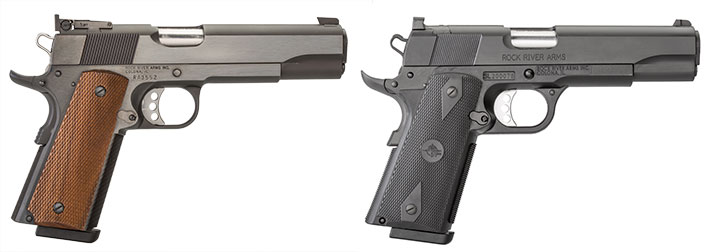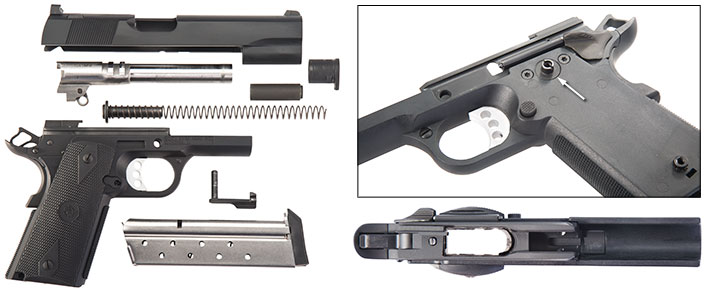
During the past two decades, polymer has steadily replaced steel as the primary material for handgun frames. Reasons for this revolve around the popularity of some of the designs that use the frame material but also include weight savings, weather resistance and lower cost relative to steel. It was only a matter of time before a polymer frame came to the very archetype of a steel-frame pistol—the M1911. Rock River Arms, long known for its custom and semi-custom steel M1911s, now offers the Poly 1911 in both 9 mm Luger and .45 ACP, incorporating a modular polymer frame into an otherwise traditional single-stack M1911 design.
Rock River Arms has a solid background with the M1911, having started in 1996 as a parts maker for M1911s and, shortly thereafter, moving into complete high-end pistols. The manufacturer shifted much of its production to ARs during the unprecedented demand of the Obama years, but has always had a strong association with the M1911 and has taken the platform in a new direction with the Poly line.
Until now, polymer-based M1911s have typically been wide-frame guns fed from double-stack magazines as in the STI 2011 series, with the polymer being used to keep the grip as thin as possible while housing more ammunition. With more of the shooting world accustomed to polymer as normal, Rock River saw a different opportunity. Owner Chuck Larson saw a chance to replace the steel frame on a traditional single-stack M1911 with polymer, creating a pistol as light as aluminum-framed “carry” M1911s while leveraging the material savings to offer a Rock River-quality production pistol at a price point accessible to a wider market.

The Poly utilizes a serialized steel chassis, much like the SIG Sauer P320 or Beretta APX, which acts as the pistol’s “skeleton” and incorporates the rails on which the slide reciprocates. The polymer frame is wrapped around that chassis and is secured by screws. This creates the potential for modularity, since the “firearm” is technically the serialized steel chassis, allowing a buyer to swap out frames should Rock River mold additional colors or features such as light rails in the future.
The polymer frame is cleverly engineered to make maximum use of standard M1911 parts. Aside from the magazine release, it appears that each part is pure M1911, allowing shooters to take advantage of the aftermarket for any customization. The pistols are equipped with lightweight, medium-length triggers, skeletonized hammers, wide beavertail grip safeties and standard, shelf thumb safeties.
Using a polymer frame on the M1911, like any departure from a century-plus-long standard, creates differences. The “feel” is definitely M1911, but, at the same time, is substantially thicker in the hand. The frame measures about 0.937" wide at the base of the trigger guard, about 0.175" thicker than a steel pistol. This lends the Poly a slightly squarer frontstrap, and puts the molded-in 25-lines-per-inch (l.p.i.) checkering in positive contact with the firing grasp. With the addition of the molded rubber stocks, the pistols are hand-filling. Those shooters coming from double-stack pistols may find this familiar and a plus, while M1911 guys or gals that immediately put thin stocks on Old Slabsides will notice the additional thickness.
The Rock Rivers are somewhat unique from other polymer-framed M1911s in that there are actual stock screw bushings threaded into the frame to accept removable stocks. Most polymer M1911-style pistols have a single molded frame with texturing pressed in. I was curious about what the Poly would feel like with thin stock panels onboard, and I happened to have a pair of VZ thin G10 panels from another pistol. With the thin stocks on, the feel was very similar to a traditional M1911 with robust wood or G10 panels, measuring 1.316" in width compared to the 1.319" across for my most-used M1911 with Craig Spegel cocobolo panels.
One of the downsides to the M1911 for many is trying to rapidly reload the single-stack magazines into a relatively small magazine well. One of the first things I do to any of my personal M1911s is to install some type of enlarged magazine well. With the Rock River Polys, this is probably unnecessary. The extra thickness in the frame allows a nicely beveled magazine well to be molded-in, and it serves as just enough extra “funnel” to be an improvement over the slightly beveled opening of a traditional steel pistol.

The Polys’ extra thickness through the frame and dustcover require a dedicated holster in many cases. From the pile I had on hand, I was able to use a Wilson Combat Practical model designed to accommodate both standard and railed M1911s. Rock River is working with several makers to bring fitted holsters to market. In the meantime, a shooter may be able to use some of the multi-fit holsters on the market or find an approximate fit from another model in the inevitable spare holster box many of us shooters have.
In addition to being an ammunition reservoir, a semi-automatic handgun frame acts as a foundation for a reliable operating system, but without a good set of sights and a nice trigger release the overall package is doomed. The sights on the Polys are Rock Rivers’ own, and consist of a dovetailed front and rear that were well-blended into the slide. The front is a 0.120" serrated face, and the rear is finely and deeply serrated as well, with an excellent picture afforded to the shooter. Sight preference is personal, but I found the picture on the pistols to be among the best I’ve seen. The forward edge of the rear sight is aggressively concave to allow the slide to hook a surface in one-handed manipulations as in clearing a stoppage or releasing the slide in a reload.
The trigger and internals are all traditional M1911, and Rock River has deep experience in building semi-custom match M1911s with 50-yd. accuracy guarantees. That lineage shows in both pistols. The 9 mm gun’s trigger broke at 4 lbs., 8 ozs., and the .45 dropped the hammer at 4 lbs., 4 ozs.
The M1911’s trigger is one of its most highly regarded characteristics. Gun writers have long run out of new ways to express how good the break on a tuned M1911 is. In my world, practical M1911s are on their own distinct scale of 1-10, and the better factory guns are probably in the sevens or low eights nowadays. I’d rate both of the Rock River Polys high; the 9 mm is subjectively a 9.1 and the .45 a 9.5. They were both crisp, predictable and with just enough weight to allow the shooter to get aggressively to the trigger without fear, but just light enough to facilitate great hits.
The Polys I received for evaluation were close siblings, with only a few differences separating them from being a matched pair. The .45 ACP’s barrel was of traditional M1911 design, while the 9 mm used the ramped design more appropriate to that cartridge. The slide stop pin protruded through the frame on the .45, whereas the 9 mm pin ended flush with the frame. The slide markings were also slightly different on both pistols, but, in handling and overall feel, they were essentially identical.
Both pistols cycled smoothly and lock into battery gracefully and firmly, with “lock” being the precise term. Neither exhibited play in any direction when in battery, feeling much closer to a custom-fitted M1911 than the typical factory gun. In fact, the same craftsmen who carefully build Rock River’s custom line produce the Poly, and there is some hand-fitting that occurs as necessary. This was borne out in accuracy testing as can be seen in the table on p. 73.
The pistols were as accurate in drills as they were from support. Eight-inch MGM steel plates were easy-money with either pistol out to 40-plus yds. My ability to guarantee hits depends on the accuracy, sights and trigger of the pistol in question, and the Poly 1911s gave me a solid interval of extra yardage. As an example, at a step shy of 60 yds., the 9 mm stacked five hits on an 8" plate in as many rounds, placing 125-gr. Hornady Steel Match into a fist-size group.
Recoil is highly subjective, but my perception in firing the Rock River Poly 1911s back-to-back with steel-frame pistols was that there was very little additional impulse. Physics would indicate there should be more recoil from a similar but lighter handgun, but the difference was so slight as to possibly go unnoticed by many. My guess is that the soft-shooting qualities may be a combination of the more hand-filling frame and, perhaps, some dampening quality in the polymer itself. Whatever the case, the times I shot the 10-yd. plate rack, and other standard drills, were very similar to what I have recorded with custom steel M1911s in each chambering.
Both pistols were simply reliable without caveat. The .45 gobbled up everything from Black Hills’ target lead semi-wadcutters to Super Vel +P JHPs, and everything in between in both the included eight-round magazines and Wilson Combat seven- and eight-rounders. The 9 mm shot ball and hollow points from 115 to 147 grs. loaded by Black Hills, Hornady, Federal and Wilson Combat. M1911s in 9 mm have somewhat of a reputation for being magazine-sensitive, but the Poly ran 100 percent over approximately 800 rounds with both the included nine rounders as well as 10-round magazines from Wilson Combat and Metalform.

I had two small issues with the test pistols. One, both of the pistols had a grip screw bushing unthread along with a grip screw. This was resolved easily enough with thread-locking compound. The second was that the standard thumb safety on each pistol was quite stiff to disengage. The 9 mm pistol broke in to an acceptable degree while the .45’s safety remained stiff enough to require very specific effort to disengage. Were the pistol my own, I would either have Rock River address it as a warranty item or, more likely, replace the safety with an extended unit.
Overall, the pistols’ performance and level of quality stand out very well at their price point. Both pistols were enjoyable to shoot and tended to make the shooter look good. The polymer frame may be a little off-putting to traditionalists, but, over time, I warmed up to the feel, actually liking the amount of contact I gained with the frontstrap and checkering. The weight savings may also tempt some to consider the Poly as a concealed carry candidate.
It says quite a bit about the enduring allure of John M. Browning’s M1911 that more than 100 years after its development companies are adapting the most current innovations to the platform while trying to maintain as much as possible about the established design and features. The Rock River Poly is an interesting mix of the best of the old and new.





































